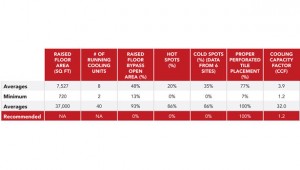This winter’s print edition of Mission Critical Magazine features a piece by Upsite Technologies’ Senior Engineer, Lars Strong. From the article:

There are two primary trends driving data center efficiency, rising cost of electricity and increasing server density. Cooling systems are responsible for consuming about half of a typical data center’s power, making cooling infrastructure a data center’s most energy-intensive subsystem. This and the need for maximizing cooling capacity are driving efforts to improve data center cooling efficiency. Eliminating data center cooling over-capacity is often the easiest and lowest cost approach to reducing data center utility costs. Research by Upsite Technologies reveals that of 45 sites studied, the average site had nearly four times more rated cooling capacity than heat load. Once an afterthought, efficient and effective computer room cooling must now be a top priority for data center and facilities managers.

KNOWING YOUR COOLING CAPACITY FACTOR
Although power usage effectiveness (PUE) has been embraced both domestically and internationally as a comprehensive metric for determining overall data-center efficiency, it does not indicate cooling effectiveness or efficiency. A metric focused solely on cooling efficiency is essential to identifying describing and isolating efficiency problems relating to cooling. One such metric is called the cooling capacity factor (CCF).
The CCF reflects the percentage of cooling capacity actually used for cooling; it is calculated by dividing total rated cooling capacity (kW) by 110% of the IT critical load (kW). The 110% figure is used to account for additional room load, including lights, people, and building envelope not reflected in the UPS output. (A complimentary CCF calculator can be found at http://upsite.com/cooling-capacity-factor-calculator.)
The CCF can indicate the extent of stranded capacity, over-deployed cooling and redundancy, and can therefore be used to determine the extent of possible reductions in cooling energy costs. When airflow is optimized and redundant systems are placed in inactive standby, operational cost savings are immediately realized from reduced expenditures for maintenance and cooling-unit/fan-motor electricity.
CASE STUDY: CALCULATING THE CCF
Upsite used the CCF to calculate the potential cost savings of improving airflow management (AFM) in the computer room of an international insurance company. The CCF of the facility was determined to be 3.1, which means the rated capacity of the cooling infrastructure was 310% of what was needed to support the IT load. The CCF showed that in this case, an astonishing 18 cooling units could be turned off if AFM improvements were made. Potential electrical load reduction was an estimated 122kW. The total resulting cost savings that could be realized from AFM improvements was conservatively estimated at $165,972/year:
122 kW x 24 hours/day x 30.4 days/month x $0.12/kWh = $10,681/month = $128,172/year
Cost savings from reduced maintenance was estimated similarly at:
18 x $175/unit-month = $3,150/month = $37,800/year
The total direct savings estimate was $13,831/month, or $165,972/year


